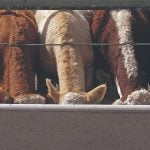A common concern in agricultural circles is what proportion or percentage of the price of a litre of milk, a loaf of bread or a beef steak makes its way back to the producer. I have written and spoken about this before, but I cannot do so again without first admitting that I have sometimes contributed to the confusion.
Back in the mid-1970s, when this issue was a hot topic, I decided to try to reconstruct the properly weighted value of a beef carcass by gathering price information on the individual retail cuts of beef from fed cattle. Canfax does so presently with the Canadian Boxed Beef Report.
To my knowledge, no entity in Canada provides a report on price spreads in the beef industry. So, I turned to the Economic Research Service (ERS) of the United States Department of Agriculture. That service computes a monthly, quarterly and annual analysis and the one I am using is the report for the entire 2021 year. In those reports, the prices are expressed as cents per pound of retail product, which I simply convert to dollars per pound.
Read Also

Treaty Land Sharing Network expands reach in Saskatchewan and Alberta
The Treaty Land Sharing Network, which connects land holders with First Nations and Metis people, has expanded since it began in 2018
The relevant information from that report is that in 2021 the “farmer’s share” of the final retail value was 36.9 per cent of the total, while the processor or wholesale share was 21.6 per cent of the total and the retail share was 41.5 per cent.
So, what does this information tell us? As a static string of numbers, it tells us little. But as part of a long-term data set, any changes in the above ratios may be of more interest from a competitiveness perspective, as the following may illustrate.
In doing this research it struck me that I now had data on six years from 2016 to 2021 inclusive, plus the first four months of 2022. The first four years were pre-COVID-19 years and 2020 and 2021 were COVID years (see below).

I was not trying to unearth some sort of causal link between this analysis and the pandemic, but the pandemic itself was a very traumatic event and I thought it reasonable to see whether there was any apparent impact on price or value spreads. So, I decided to compare the first four-year averages with the averages for the last two years. Here is what I found (as presented in the table on the following page).
- The gross farm value declined by 3.24 per cent from $2.85 to $2.76 per pound of retail beef.
- The farm-to-wholesale spread doubled from $0.66 to $1.38.
- The retail value increased 15.8 per cent from $5.96 to $6.90.
- The farmer’s share averaged 43.90 per cent of the total in the four pre-COVID years and 37.05 per cent in the next two years.
In sum, a bigger piece of the pie went to the processor and the retailer with a smaller share going to the farmers.
But here is where I must concede my earlier error in logic. How would a lower retail price or share benefit the producer? Logically, a lower retail price might lead to higher consumption and increased demand. But it would also mean, undisputedly, that less money was flowing into the industry. How does that help?
The retailer sets its price “after the fact,” meaning that the weaned calf and the processed animal have already been sold. In other words, the retailer already owns the product and can charge whatever it pleases. Charging what the market will bear is, after all, the essence of free enterprise.
A complicating factor is that the price structure at the farm and feedlot level is almost completely dominated by the U.S. industry, and the Canadian industry does not have the leverage to alter that significantly.
Another point tucked away in this data is the fact that the cow-calf and the feedlot sectors are viewed in the ERS report as a single entity when in fact they are now distinctly separate. That suggests that one so inclined could complain about the spread between the cow-calf share and the feedlot share.
So, what is right or wrong about these shifts in revenue shares and, more to the point, what can be done about it? I ask this question here to invite comment, including criticism. The issue of price discovery is always topical.
I understand there is ongoing discussion and debate about the pricing structure. In a sense, the free, open and competitive marketing system is on trial. I recommend caution in any attempt to manage prices.
While pondering this issue I recalled that beginning in about 2017, a sharp increase in imported cattle commenced and continues to increase year-over-year to the present level of over 400,000 head in 2021. So, we have a kind of Gordian knot here, where the domestic beef cow herd is declining even as feedlot requirements are increasing. On top of that, the numbers of herds are also declining.
In an earlier issue of this magazine, I referred to the cow-calf sector as the “forgotten sector.” I have often thought it odd that the herd owner must pay for and install the national ID tags but so far gets the least benefit from this innovation. It is there, where the problem seems gravest, that I suggest the solution must be found and that solution will require a steep increase in the flow of important information back to the cow-calf sector. It is, after all, the foundation of the entire industry.
















